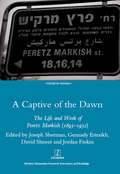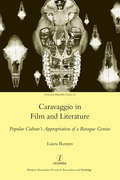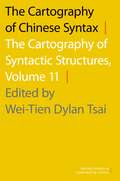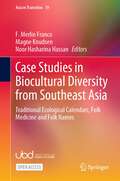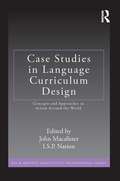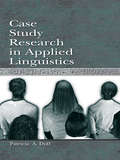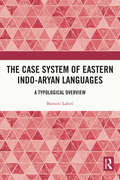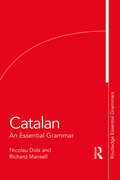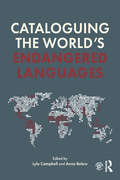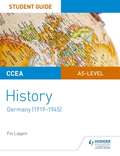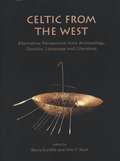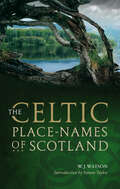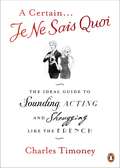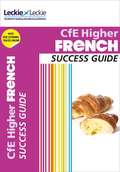- Table View
- List View
A Captive of the Dawn: The Life and Work of Peretz Markish (1895-1952)
by Joseph ShermanPeretz Markish (1895-1952), one of Eastern Europe's most important Yiddish poets in the period between the two world wars, was a fiercely independent maverick who published work in all literary genres. Although emerging from the Kiev literary tradition, Markish always went his own way in a literary career spanning four decades and embracing almost
Caravaggio in Film and Literature: Popular Culture's Appropriation of a Baroque Genius
by Laura RoratoAlthough fictional responses to Caravaggio date back to the painter's lifetime (1571-1610), it was during the second half of the twentieth century that interest in him took off outside the world of art history. In this new monograph, the first book-length study of Caravaggio's recent impact, Rorato provides a panoramic overview of his appropriation by popular culture. The extent of the Caravaggio myth, and its self-perpetuating nature, are brought out by a series of case studies involving authors and directors from numerous countries (Italy, Great Britain, America, Canada, France and Norway) and literary and filmic texts from a number of genres - from straightforward tellings of his life to crime fiction, homoerotic film and postcolonial literature.
Caravaggio in Film and Literature: Popular Culture's Appropriation of a Baroque Genius
by Laura RoratoAlthough fictional responses to Caravaggio date back to the painter's lifetime (1571-1610), it was during the second half of the twentieth century that interest in him took off outside the world of art history. In this new monograph, the first book-length study of Caravaggio's recent impact, Rorato provides a panoramic overview of his appropriation by popular culture. The extent of the Caravaggio myth, and its self-perpetuating nature, are brought out by a series of case studies involving authors and directors from numerous countries (Italy, Great Britain, America, Canada, France and Norway) and literary and filmic texts from a number of genres - from straightforward tellings of his life to crime fiction, homoerotic film and postcolonial literature.
The Cartography of Chinese Syntax: The Cartography of Syntactic Structures, Volume 11 (Oxford Studies in Comparative Syntax)
This edited volume provides new insights into the architecture of Chinese grammar from a comparative perspective, using principles of cartography. Cartography is a research program within syntactic theory that is guided by the view that syntactic structures contain grammatical and functional information that is ideal for semantic interpretation - by studying the syntactic structures of a particular language, syntacticians can better understand the semantic issues at play in that language. The chapters in this book map out the "topography" of a variety of constructions in Chinese, specifically information structure, wh-question formation, and peripheral functional elements. The syntactic structure of Chinese makes it an ideal language for this line of research, because functional elements are often spread throughout sentences rather than clumped together as is usually dictated by language-specific morphology. Mapping Chinese syntactic structures therefore offers a window into the origin of heavily "scrambled" constructions often observed in other languages. The book includes a preface that will discusses the goal of cartography and explains how the collection contributes towards our understanding of this approach to syntax. The subsequent seven original articles all contain original syntactic data that is invaluable for future research in cartography, and the collection as a whole paints a broader picture of how the alignment between syntax and semantics works in a principled way.
Case and Linking in Language Comprehension: Evidence from German (Studies in Theoretical Psycholinguistics #34)
by Markus Bader Josef BayerCase Studies in Biocultural Diversity from Southeast Asia: Traditional Ecological Calendars, Folk Medicine and Folk Names (Asia in Transition #19)
by Noor Hasharina Hassan F. Merlin Franco Magne KnudsenThis open access book demonstrates the linkages between local languages, traditional knowledge, and biodiversity at the landscape level in Asia, providing a fresh approach to discussions on Asia’s biocultural diversity. The book carries forward earlier analyses but importantly focuses on ‘traditional ecological calendars,’ ‘folk medicine,’ and ‘folk names’ in the context of the vital importance of maintaining biological, cultural, and linguistic diversity. It does this by addressing a range of cases and issues in relation to Southeast Asia: Brunei Darussalam, Indonesia, Malaysia, the Philippines, and North-East India. The several chapters demonstrate the ways in which the various forms of knowledge of the environment and its categorizations are important in areas such as landscape and resource management and conservation. They also demonstrate that environmental knowledge and the practical skills which accompany it are not necessarily widely shared. This book sends important messages to those who care about the sustainability of our environment, the maintenance of its biocultural diversity, or at least the maintenance of what remains of it because much has changed. This interdisciplinary collection draws from a wide range of disciplines and is of appeal to students and scholars in anthropology, environmental studies, geography, biodiversity, and linguistics.
Case Studies in Language Curriculum Design: Concepts and Approaches in Action Around the World (ESL & Applied Linguistics Professional Series)
by John Macalister I.S.P. NationCase studies are a powerful pedagogical tool for illuminating constructs and models in real-life contexts. Covering a wide range of teaching-learning contexts and offering in-depth analyses of ESL/ELT language curriculum design issues, this casebook is distinctive and unique in that each case draws on and is clearly linked to a single model presented in Nation and Macalister’s Language Curriculum Design (www.routledge.com/9780415806060), giving the book a high degree of coherence. A short commentary by the editors after each case highlights features of note and/or issues arising from it. This is a versatile text, designed to work as a companion to Language Curriculum Design (adding meaning and depth to the model presented there by relating it to a range of applications), as a stand-alone text, or as a resource for language teacher trainees, teacher educators, practicing teachers, program administrators, and materials writers in the field.
Case Studies in Language Curriculum Design: Concepts and Approaches in Action Around the World (ESL & Applied Linguistics Professional Series)
by John Macalister I.S.P. NationCase studies are a powerful pedagogical tool for illuminating constructs and models in real-life contexts. Covering a wide range of teaching-learning contexts and offering in-depth analyses of ESL/ELT language curriculum design issues, this casebook is distinctive and unique in that each case draws on and is clearly linked to a single model presented in Nation and Macalister’s Language Curriculum Design (www.routledge.com/9780415806060), giving the book a high degree of coherence. A short commentary by the editors after each case highlights features of note and/or issues arising from it. This is a versatile text, designed to work as a companion to Language Curriculum Design (adding meaning and depth to the model presented there by relating it to a range of applications), as a stand-alone text, or as a resource for language teacher trainees, teacher educators, practicing teachers, program administrators, and materials writers in the field.
Case Study Research in Applied Linguistics
by Patricia DuffCase studies of individual language learners are a valuable means of illustrating issues connected with learning, using, and in some cases, losing another language. Yet, even though increasing numbers of graduate students and scholars conduct research using case studies or mix quantitative and qualitative methods, there are no dedicated applied linguistics research methods texts that guide one through the case study process. This book fills that gap. The volume provides an overview of case study methodology and examples of published case studies in applied linguistics, without attempting to be a comprehensive survey of the innumerable case studies that exist. The case studies presented here involve teachers and learners of English and various other languages in North America and other parts of the world. Advice is also given about how to conduct and publish case studies. Case Study Research in Applied Linguistics is designed for students, both undergraduate and graduate, as well as other scholars seeking to understand case study methods and their applications in research on language learners and language users in a variety of contexts. Applied linguists working in other subfields will find the volume useful in their own research and in their supervision and evaluation of others' case studies.
Case Study Research in Applied Linguistics (Second Language Acquisition Research Ser.)
by Patricia DuffCase studies of individual language learners are a valuable means of illustrating issues connected with learning, using, and in some cases, losing another language. Yet, even though increasing numbers of graduate students and scholars conduct research using case studies or mix quantitative and qualitative methods, there are no dedicated applied lin
The Case System of Eastern Indo-Aryan Languages: A Typological Overview
by Bornini LahiriThis book presents a typological overview of the case system of Eastern Indo-Aryan (EIA) languages. It utilises a cognitive framework to analyse and compare the case markers of seven EIA languages, namely Angika, Asamiya, Bhojpuri, Bangla, Magahi, Maithili and Odia. The book introduces semantic maps, which had hitherto not been used for Indian languages, to plot the scope of different case markers and facilitate cross-linguistic comparison of these languages. It also offers a detailed questionnaire specially designed for fieldwork and data collection which will be extremely useful to researchers involved in the study of ‘case’. A unique look into the linguistic traditions of South Asia, the book will be indispensable to academicians, researchers, and students of language studies, linguistics, literature, cognitive science, psychology, language technologies and South Asian studies. It will also be useful for linguists, typologists, grammarians and those interested in the study of Indian languages.
The Case System of Eastern Indo-Aryan Languages: A Typological Overview
by Bornini LahiriThis book presents a typological overview of the case system of Eastern Indo-Aryan (EIA) languages. It utilises a cognitive framework to analyse and compare the case markers of seven EIA languages, namely Angika, Asamiya, Bhojpuri, Bangla, Magahi, Maithili and Odia. The book introduces semantic maps, which had hitherto not been used for Indian languages, to plot the scope of different case markers and facilitate cross-linguistic comparison of these languages. It also offers a detailed questionnaire specially designed for fieldwork and data collection which will be extremely useful to researchers involved in the study of ‘case’. A unique look into the linguistic traditions of South Asia, the book will be indispensable to academicians, researchers, and students of language studies, linguistics, literature, cognitive science, psychology, language technologies and South Asian studies. It will also be useful for linguists, typologists, grammarians and those interested in the study of Indian languages.
Catalan: An Essential Grammar
by Nicolau Dols Richard MansellCatalan: An Essential Grammar is a concise and convenient guide to the basic grammatical structure of Catalan. Presenting a fresh and accessible description of the language, this engaging Grammar uses clear explanations and sets out the complexities of Catalan in short, readable sections clarified by examples. Quick reference overviews are also provided in the appendix. Catalan: An Essential Grammar is the ideal reference grammar for all learners of Catalan, whether class-based or independent, looking to progress beyond beginner level.
Catalan: An Essential Grammar (Routledge Comprehensive Grammars Ser.)
by Richard Mansell Nicolau DolsCatalan: An Essential Grammar is a concise and convenient guide to the basic grammatical structure of Catalan. Presenting a fresh and accessible description of the language, this engaging Grammar uses clear explanations and sets out the complexities of Catalan in short, readable sections clarified by examples. Quick reference overviews are also provided in the appendix. Catalan: An Essential Grammar is the ideal reference grammar for all learners of Catalan, whether class-based or independent, looking to progress beyond beginner level.
Catalogue of Chinese Manuscripts in Danish Archives: Chinese diplomatic correspondence from the Ch'ing dynasty (1644-1911) (Routledge Revivals)
by Erik BaarkFirst published in 1980, Catalogue of Chinese Manuscripts in Danish Archives is a descriptive catalogue that gives the date, address, and a summary of the contents for some 500 Chinese manuscripts in three Danish archives: the National Archives, the National Museum, and the Archives of the Great Northern Telegraph Company. The Chinese diplomatic correspondence kept in these archives form important source material for the study of Sino-Danish relations in the nineteenth century. In addition, the contents of the manuscripts shed an interesting light on the way Chinese and foreign diplomacy at the lowest level was conducted during the crucial years of Sino-Western relations. The book contains an introduction and two indexes, one for the names mentioned in the addresses, and one for the subjects and names mentioned in the summaries. The book will appeal to students of history, political science, international relations and diplomacy.
Catalogue of Chinese Manuscripts in Danish Archives: Chinese diplomatic correspondence from the Ch'ing dynasty (1644-1911) (Routledge Revivals)
by Erik BaarkFirst published in 1980, Catalogue of Chinese Manuscripts in Danish Archives is a descriptive catalogue that gives the date, address, and a summary of the contents for some 500 Chinese manuscripts in three Danish archives: the National Archives, the National Museum, and the Archives of the Great Northern Telegraph Company. The Chinese diplomatic correspondence kept in these archives form important source material for the study of Sino-Danish relations in the nineteenth century. In addition, the contents of the manuscripts shed an interesting light on the way Chinese and foreign diplomacy at the lowest level was conducted during the crucial years of Sino-Western relations. The book contains an introduction and two indexes, one for the names mentioned in the addresses, and one for the subjects and names mentioned in the summaries. The book will appeal to students of history, political science, international relations and diplomacy.
Cataloguing the World's Endangered Languages
by Lyle Campbell Anna BelewCataloguing the World’s Endangered Languages brings together the results of the extensive and influential Catalogue of Endangered Languages (ELCat) project. Based on the findings from the most extensive endangered languages research project, this is the most comprehensive source of accurate information on endangered languages. The book presents the academic and scientific findings that underpin the online Catalogue, located at www.endangeredlanguages.com, making it an essential companion to the website for academics and researchers working in this area. While the online Catalogue displays much data from the ELCat project, this volume develops and emphasizes aspects of the research behind the data and includes topics of great interest in the field, not previously covered in a single volume. Cataloguing the World’s Endangered Languages is an important volume of particular interest to academics and researchers working with endangered languages.
Cataloguing the World's Endangered Languages
by Lyle Campbell Anna BelewCataloguing the World’s Endangered Languages brings together the results of the extensive and influential Catalogue of Endangered Languages (ELCat) project. Based on the findings from the most extensive endangered languages research project, this is the most comprehensive source of accurate information on endangered languages. The book presents the academic and scientific findings that underpin the online Catalogue, located at www.endangeredlanguages.com, making it an essential companion to the website for academics and researchers working in this area. While the online Catalogue displays much data from the ELCat project, this volume develops and emphasizes aspects of the research behind the data and includes topics of great interest in the field, not previously covered in a single volume. Cataloguing the World’s Endangered Languages is an important volume of particular interest to academics and researchers working with endangered languages.
CCEA AS-level History Student Guide: Germany (1919-1945)
by Fin LappinBuild, reinforce and assess students' knowledge throughout their course; tailored to the 2016 CCEA specification and brought to you by the leading History publisher, this study and revision guide combines clear content coverage with practice questions and sample answers. - Ensure understanding of the period with concise coverage of all Unit content, broken down into manageable chunks- Develop the analytical and evaluative skills that students need to succeed in A-level History- Consolidate understanding with exam tips and knowledge-check questions- Practise exam-style questions matched to the CCEA assessment requirements for every question type, including source-based examples- Improve students' exam technique and show them how to reach the next grade with sample student answers and commentary for each exam-style question- Use flexibly in class or at home, for knowledge acquisition during the course or focused revision and exam preparation
CCEA AS-level History Student Guide: Germany (1919-1945)
by Fin LappinBuild, reinforce and assess students' knowledge throughout their course; tailored to the 2016 CCEA specification and brought to you by the leading History publisher, this study and revision guide combines clear content coverage with practice questions and sample answers. - Ensure understanding of the period with concise coverage of all Unit content, broken down into manageable chunks- Develop the analytical and evaluative skills that students need to succeed in A-level History- Consolidate understanding with exam tips and knowledge-check questions- Practise exam-style questions matched to the CCEA assessment requirements for every question type, including source-based examples- Improve students' exam technique and show them how to reach the next grade with sample student answers and commentary for each exam-style question- Use flexibly in class or at home, for knowledge acquisition during the course or focused revision and exam preparation
Celtic From The West: Alternative Perspectives From Archaeology, Genetics, Language And Literature (PDF) (Celtic Studies Publications #15)
by John T. Koch Barry W. CunliffeThis book is an exploration of the new idea that the Celtic languages originated in the Atlantic Zone during the Bronze Age, approached from various perspectives pro and con, archaeology, genetics, and philology. This Celtic Atlantic Bronze Age theory represents a major departure from the long-established, but increasingly problematical scenario in which the story of the Ancient Celtic languages and that of peoples called Keltoì Celts are closely bound up with the archaeology of the Hallstatt and La Tène cultures of Iron Age west-central Europe. The Celtic from the West proposal was first presented in Barry Cunliffe's Facing the Ocean (2001) and has subsequently found resonance amongst geneticists. It provoked controversy on the part of some linguists, though is significantly in accord with John Koch's findings in Tartessian (2009). The present collection is intended to pursue the question further in order to determine whether this earlier and more westerly starting point might now be developed as a more robust foundation for Celtic studies. As well as having this specific aim, a more general purpose of Celtic from the West is to bring to an English-language readership some of the rapidly unfolding and too often neglected evidence of the pre-Roman peoples and languages of the western Iberian Peninsula. Celtic from the West is an outgrowth of a multidisciplinary conference held at the National Library of Wales in Aberystwyth in December 2008. As well as the 11 chapters, the book includes 45 distribution maps and a further 80 illustrations. The conference and collaborative volume mark the launch of a multi-year research initiative undertaken by the University of Wales Centre for Advanced Welsh and Celtic Studies [CAWCS]: Ancient Britain and the Atlantic Zone [ABrAZo]. Contributors: (Archaeology) Barry Cunliffe; Raimund Karl; Amìlcar Guerra; (Genetics) Brian McEvoy & Daniel Bradley; Stephen Oppenheimer; Ellen Rrvik; (Language & Literature) Graham Isaac; David Parsons; John T. Koch; Philip Freeman; Dagmar S. Wodtko.
The Celtic Place-names of Scotland
by W. J. WatsonFirst published in 1926, this book remains the best and most comprehensive guide to the Celtic place-names of Scotland and is essential reading for anyone interested in Scottish history and the derivations of place-names the length and breadth of the country. It is divided into sections dealing with early names, territorial divisions, general surveys of areas, and also looks at saints, church terms and river names. As the standard reference work on the subject it has never been surpassed.This edition contains an introduction which includes biographical material about the author, together with corrigenda and addenda.
A Certain Je Ne Sais Quoi: The Ideal Guide to Sounding, Acting and Shrugging Like the French
by Charles TimoneyVocabulary alone isn't enough. To survive in the most sophisticated - and the most scathing - nation on Earth you will need to understand the many peculiarities of the (very peculiar) French culture. And for that you need A Certain Je Ne Sais Quoi.If you want to fit in with the French you'll have to know how to deal with sardonic waiters; why French children hate Charlemagne; the etiquette of kissing, joke-telling and drinking songs, what to do with a bidet, the correct recipe for a salade nicoise and, of course, how to convey absolute, shattering indifference with a single syllable (Bof!).Charles Timoney, the author of Pardon My French, provides a practical, pleasurable guide to the charms of the Gallic people - from their daily routines to their peerless gesticulations, from their come-ons to their put-downs. Read on and put the oh la la back into your French vacances. Your inner gaul will thank you for it.
CfE Higher French: Success Guide (PDF)
by Robert Kirk Leckie Leckie Staff Collins Uk StaffExam Board: SQA Level: Higher Subject: French First Teaching: 2014, First Exam: 2015 Prepare to excel in your CfE Higher SQA exam with this Success Guide – the first choice for Scottish students! Prepare to excel in your CfE Higher French SQA examination with this Success Guide – the first choice for successful Scottish students! Success Guides really work because: • Topics in user-friendly sections help you plan your revision in bite-sized chunks • Quick Tests provide the practice that experts say is essential for effective recall • Top tips throughout ensure you know what the examiner will be looking for • Detailed guidance on the exam and Assignment will ensure that you know exactly what you need to do in the assessments • Examples throughout explain new ideas clearly
CfE Higher French: Success Guide (PDF)
by Robert Kirk Leckie Leckie Staff Collins Uk StaffExam Board: SQA Level: Higher Subject: French First Teaching: 2014, First Exam: 2015 Prepare to excel in your CfE Higher SQA exam with this Success Guide – the first choice for Scottish students! Prepare to excel in your CfE Higher French SQA examination with this Success Guide – the first choice for successful Scottish students! Success Guides really work because: • Topics in user-friendly sections help you plan your revision in bite-sized chunks • Quick Tests provide the practice that experts say is essential for effective recall • Top tips throughout ensure you know what the examiner will be looking for • Detailed guidance on the exam and Assignment will ensure that you know exactly what you need to do in the assessments • Examples throughout explain new ideas clearly
